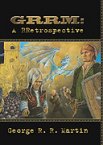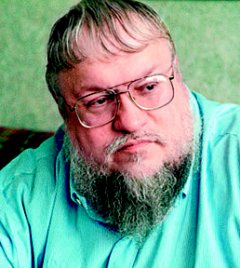Excerpts from the interview:
“I like not having to write to length. This is probably the result of my years in Hollywood, where if they want 46 minutes they won't give you a 47th minute just because you think the story needs it. 'One more scene? Well no, we've got to put in a commercial.' There's a little more leeway in movies, but they still expect you to come in at around two, two and a half, hours. My stuff was always too long, so when I got out of that environment and back to books I wanted to do something that was large, that had the cast of thousands, the epic scope. There's a lot to be gained by that, for a writer. You can present a story that has considerable scale and complexity, and you can develop these characters by following them for years through many different circumstances, interacting with different characters and behaving in contradictory manners -- all the complexity of a real human being. You can flesh out the characters in ways it's much more difficult to do if you have less space.
“Some of the critics in the field seem to have a very negative feeling toward anything that's part of a series, this feeling that the standalone novel is innately superior. I don't think that's necessarily true. They're judging the multivolume novel, the series novel, by its worst examples in the same way that science fiction over its history has been condemned to being judged by its worst examples. Yes, there are some dreadful, bloated series out there, but that doesn't need to be inherent to the form.
 “Of course it can be a challenge. I knew very soon after I started the Song of Ice and Fire series that it was going to take longer than my previous books. My original contract (going back to the mid-'90s) had one-year deadlines because that was basically what it had always taken me on my previous novels, before my years in Hollywood. Having that deadline was a grievous error, as I learned when I got into A Game of Thrones. What I had completely failed to take into account was that these books were three times as long as the others!
“Of course it can be a challenge. I knew very soon after I started the Song of Ice and Fire series that it was going to take longer than my previous books. My original contract (going back to the mid-'90s) had one-year deadlines because that was basically what it had always taken me on my previous novels, before my years in Hollywood. Having that deadline was a grievous error, as I learned when I got into A Game of Thrones. What I had completely failed to take into account was that these books were three times as long as the others!
“Even so, they were taking about two years. Now it has been five years between books, which is far too much, and I'm not entirely sure why that happened. Some of it involves plot strategy. Back at the Philadelphia Worldcon (which seems a million years ago), I announced the famous five-year gap: I was going to skip five years forward in the story, to allow some of the younger characters to grow older and the dragons to grow larger, and for various other reasons. I started out writing on that basis in 2001, and it worked very well for some of my myriad characters but not at all for others, because you can't just have nothing happen for five years. If things do happen you have to write flashbacks, a lot of internal retrospection, and that's not a good way to present it. I struggled with that essentially wrong direction for about a year before finally throwing it out, realizing there had to be another interim book. That became A Feast for Crows, where the action is pretty much continuous from the preceding book.
“Even so, that only accounts for one year. Why the four after that? I don't know, except that this was a very tough book to write -- and it remains so, because I've only finished half. Going in, I thought I could do something about the length of the second book in the series, A Clash of Kings, roughly 1,200 pages in manuscript. But I passed that and there was a lot more to write. Then I passed the length of the third book, A Storm of Swords, which was something like 1,500 pages in manuscript and gave my publishers all around the world lots of production problems. I didn't really want to make any cuts because I had this huge story to tell. We started thinking about dividing it in two and doing it as A Feast for Crows, Parts One and Two, but the more I thought about that the more I really did not like it. Part One would have had no resolution whatsoever for 18 viewpoint characters and their 18 stories. Of course this is all part of a huge megaseries so there is not a complete resolution yet in any of the volumes, but I try to give a certain sense of completion at the end of each volume -- that a movement of the symphony has wrapped up, so to speak.”
*
 “I'm attracted to 'gray' characters, characters who are not what they seem, characters who change. I think that's the most interesting part of fiction, and a lot of fantasy doesn't have that. Too many characters are black and white, and everybody's fighting a Dark Lord. I just wasn't interested in writing that kind of thing. Having multiple viewpoints is crucial to the grayness of the characters. You have to be able to see the struggle from both sides because real human beings in a war have all these processes of self-justification, telling ourselves why what we're doing is the right thing. Nobody except in a cartoon says, 'I'm the Dark Lord, and now I'm going out to do Evil Things.' We are the Gray Lords! And of course you see that in real-world struggles throughout history. George Bush thinks he's right, Osama bin Laden thinks he's right, and they each think the other side is the bad guy. So you need a multiplicity of viewpoints to present any conflict that's going to be more than a cartoon one. That's where I think the structure was such an essential part of these books.”
“I'm attracted to 'gray' characters, characters who are not what they seem, characters who change. I think that's the most interesting part of fiction, and a lot of fantasy doesn't have that. Too many characters are black and white, and everybody's fighting a Dark Lord. I just wasn't interested in writing that kind of thing. Having multiple viewpoints is crucial to the grayness of the characters. You have to be able to see the struggle from both sides because real human beings in a war have all these processes of self-justification, telling ourselves why what we're doing is the right thing. Nobody except in a cartoon says, 'I'm the Dark Lord, and now I'm going out to do Evil Things.' We are the Gray Lords! And of course you see that in real-world struggles throughout history. George Bush thinks he's right, Osama bin Laden thinks he's right, and they each think the other side is the bad guy. So you need a multiplicity of viewpoints to present any conflict that's going to be more than a cartoon one. That's where I think the structure was such an essential part of these books.”
*
“The problem now is, there are too damn many books -- more and more each year, each of which has a smaller and smaller audience. Back in the '70s Dhalgren and A Mote in God's Eye came out in the same year, New Wave and old-school nuts-and-bolts science fiction. Fans of one may have hated the other, but everyone read both books because it was a small enough field and these were both important books. Now it has become not just two but fifty different audiences, each of which has its own small group of advocates.
“Fantasy and science fiction have become separate, a trend I think is particularly unfortunate. Fritz Leiber wrote The Big Time and Fafhrd and the Gray Mouser. Poul Anderson wrote The Broken Sword and Three Hearts and Three Lions, but then he wrote all the wonderful Nicolas van Rijn books. Jack Vance -- my hero! -- was a master of both forms. If you're a writer you're a writer: you can tell a story. Sometimes the difference is just the furniture. Aliens or elves, they're the Other, symbolically, metaphorically. I've always read all three of the forms. When I was a kid I'd be reading Heinlein one day and then Lovecraft or Robert E. Howard. (My father called it all 'weird stuff.') Now they've divided science fiction and fantasy into two different fields, and some people are trying to make them almost two antithetical fields. There's not enough cross-fertilization going on.”



